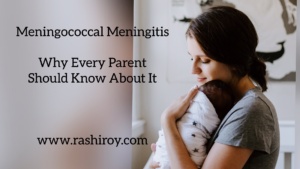
When my son was just eighteen months old, he had high fever leading to a seizure. That was the most horrifying incident for us as parents. Though the paediatrician said seizures at this age are not uncommon, it sure scared us to the core.
Post that incident, I searched on the internet the causes that can lead to such conditions. High fever was the most common reason but what caught my attention was another fatal condition that happened due to fever and that was Meningococcal Meningitis. Invasive Meningococcal Disease (IMD) is a rare but potentially devastating bacterial infection. It is commonly present as an infection of the brain (meningitis) and/or infection of the blood (septicaemia or blood poisoning). I was shocked to read that it looked like normal fever but it could kill the patient within 24 hours.(2)
Before that, I never paid much attention to the vaccinations my child had. I followed the chart given by the doctor and relied completely on that but this time I ensured to ask the paediatrician about it in the next visit.
She explained, Meningitis causes an inflammation of the covering membranes that protect the brain and the spinal cord. Some of the early warning signs that parents should keep a watch for are fever, loss of appetite and neck rigidity. Seizure is also one of the symptoms and that made me pay more attention to the information she shared. Other symptoms include nausea, skin rash, blurring of vision, drowsiness, joint pain, and confusion.(2)
What makes Bacterial Meningitis dangerous is it is more severe and can cause death or disability. Another major reason for concern is it is highly contagious. It can spread through cough or cold.(1)
My doctor also told me that about 1 in 10 people (1 out of 4 in adolescence) have meningococcal bacteria in the back of their nose or throat with no signs or symptoms of the disease; this is known as being ‘a carrier’. But the bacteria may invade the body and cause infections.(2)
While Meningococcal Meningitis mainly affects children below the age of five, adolescents and young adults, it can affect anyone, anywhere in the world. Most Meningococcal Meningitis occurs in otherwise healthy individuals without identifiable risk factors.(2)
However, the relief is, there is vaccination available and the disease can be prevented if the vaccine is taken along with routine immunization. So next time you visit your doctor, make sure you check about the vaccinations and be safe because prevention is always better than cure.
Join the movement against Meningococcal Meningitis today!
Disclaimer: The views expressed in the blog content are independent and unbiased views solely of the blogger. This is a part of public awareness initiative on meningitis supported by Sanofi Pasteur India. Sanofi Pasteur bears no responsibility for the content of the blog. One should consult their healthcare provider for any health-related information. This article is meant to help create awareness and spread knowledge. Any decision regarding your health and child’s health should be done after consultation with your doctor. While all efforts are made to keep articles updated, the speed of research in these fields mean the information often may change when more research knowledge is available. Rashi Roy or the authors should be in no way held responsible in that case.
Reference –
- Meningitis Research Foundation. What are meningitis and septicaemia. Accessed March 2019. https://www.meningitis.org/meningitis/what-is-meningitis
- Meningococcal meningitis. Accessed July 2019. https://www.who.int/news-room/fact-sheets/detail/meningococcal-meningitis




I think even those who are not parents should be aware of it.
Nice article
Thanx for the sharing such a nice information. Its helpful to all parents